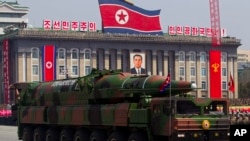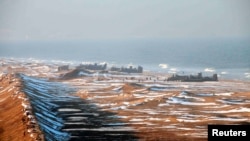At the North Korean Embassy in London, they are answering the phone but saying little.
"As far as we know, we are not giving any statements," a North Korean official told Reuters, declining to give his name and saying all necessary information was already available on the website of the North Korean state news agency KCNA.
In fact, the world, well beyond Asia, is perplexed by the mysteries of the nuclear-capable state's bellicosity and many fear mutual ignorance could help turn words into acts of war.
Many foreign analysts offer reassurance. No one, they say, really wants war. Missile and nuclear tests, threats of possible atomic strikes on the United States and military drills on both sides of the divided Korean peninsula, reflect rather a youthful North Korean leader and newly elected South Korean government both finding their feet at home and testing their strengths.
Yet neither 30-year-old Kim Jong Un, who succeeded his late father just over a year ago, nor South Korea's President Park Geun-hye is seen having much room or appetite to back down.
The risk of miscalculation or mistake sparking accidental conflict may be growing by the day - bringing with it the greatest risk in years of a regional nuclear exchange.
"We have had worrying times before, but this is bad," says Victor Cha, former director for Asian Affairs at the National Security Council under President George W. Bush.
"The rhetoric is off the charts. We don't understand this new guy at all," added Cha, who is now a senior adviser at the Center for Strategic and International Studies in Washington. "And if the North Koreans move to provoke the South, the South is going to retaliate in a way we haven't seen before."
This month's joint U.S.-South Korean military exercises have sparked outcry from the North and could make for the most dangerous weeks on the peninsula in more than two decades.
"Could go very wrong"
"There are number of ways this could go very wrong," says Ken Gause, chief North Korea specialist at the Center for Naval Analyses, a U.S. government-funded research institute that advises the U.S. military among others. "You have two new governments in North and South Korea that are still finding out where each other's red lines are."
While there is uncertainty over whether North Korea is capable of firing a nuclear device across the border or over the sea at Japan or U.S. Pacific bases, even a conventional conflict could be devastating. Meanwhile, the risk of confrontation with Pyongyang's traditional ally China also worries Washington.
The likely human and economic cost, those with knowledge of events say, was one of the key reasons Washington held back from direct military action against the North Korean nuclear programme in the 1990s to stop it completing a nuclear device.
The bottom line, veteran North Korea watchers say, is that the outside world still has little real understanding of what is happening in the secretive authoritarian state.
Satellites and spies may provide basic details of weaponry, but the intentions of those at the top remained very opaque.
"It is basically guesswork," said Mark Fitzpatrick, a one-time North Korea specialist at the U.S. State Department and later deputy head of its nuclear non-proliferation team.
"China and Russia may have a better understanding than us, but I don't believe anyone is truly on top of it," added Fitzpatrick, now a senior analyst at London's International Institute for Strategic Studies.
How much the North - and Kim Jong Un in particular - understands events outside its borders is also far from clear.
The London embassy - housed in a modest villa in the suburb of Ealing - is one of only a few overseas missions run by the administration in Pyongyang. Direct contact with foreigners is rare and many senior leaders have never left the country.
Southern readiness
South Korea is also preparing militarily. After criticism at home for muted responses to the sinking of one of its warships in 2010 and fatal shelling of an island in 2011, the government in Seoul has ramped up its readiness in case of attack.
Even an accidental incident on either side, analysts now worry, could spark dramatic and almost instantaneous escalation.
Much larger than normal, this year's annual U.S. exercises show Washington reassuring its South Korean and Japanese allies that it stands behind them. But some analysts suggest the public deployment of U.S. firepower, including B-52 and B-2 bombers, risks provoking reaction from the untried new Kim in Pyongyang.
A grandson of the founder of the communist state, he is seen still consolidating power among older generals and relatives who make up North Korea's powerful elite. That may mean burnishing his credentials by responding forcefully to perceived threats.
For all its rhetoric, however, observers say North Korea has yet to take many steps, such as deporting foreign visitors and fully mobilizing its forces, that might presage an actual war - though reports of it warning diplomats to be ready to leave Pyongyang added to the climate of tension.
The best hope for a return to calm, some analysts believe, may be that those in Pyongyang prove better at understanding the outside world than foreigners have been at understanding them.
"They have the Internet," says Chris Torrens, Asia analyst at London-based consultancy Control Risks. "It may be easier for them to look out than it is for us to look in."
"As far as we know, we are not giving any statements," a North Korean official told Reuters, declining to give his name and saying all necessary information was already available on the website of the North Korean state news agency KCNA.
In fact, the world, well beyond Asia, is perplexed by the mysteries of the nuclear-capable state's bellicosity and many fear mutual ignorance could help turn words into acts of war.
Many foreign analysts offer reassurance. No one, they say, really wants war. Missile and nuclear tests, threats of possible atomic strikes on the United States and military drills on both sides of the divided Korean peninsula, reflect rather a youthful North Korean leader and newly elected South Korean government both finding their feet at home and testing their strengths.
Yet neither 30-year-old Kim Jong Un, who succeeded his late father just over a year ago, nor South Korea's President Park Geun-hye is seen having much room or appetite to back down.
Tensions Rising on Korean Peninsula
Tensions Rising on Korean Peninsula- February 12: North Korea carries out third nuclear test
- March 27: North Korea cuts military hotline with South Korea
- March 28: U.S. B-2 bombers fly over Korean peninsula
- March 30: North Korea says it has entered a "state of war" with South Korea
- April 3: North Korea blocks South Korean workers from Kaesong
- April 4: North Korea moves a missile to its east coast
- April 9: North Korea urges foreigners to leave the South. The U.S. and South Korea raise alert level
- April 14: US Secretary of State John Kerry offers talks with Pyongyang if it moves to scrap nuclear weapons
- April 16: North Korea issues threats after anti-Pyongyang protests in Seoul
- April 29: North Korea holds back seven South Koreans at Kaesong
- April 30: North Korea sentences American to 15 years hard labor for hostile acts
- May 20: North Korea fires projectiles for a consecutive third day
- May 24: North Korean envoy wraps up China visit for talks on Korean tensions
- June 7: South Korea accepts Pyongyang's offer of talks on Kaesong and other issues
"We have had worrying times before, but this is bad," says Victor Cha, former director for Asian Affairs at the National Security Council under President George W. Bush.
"The rhetoric is off the charts. We don't understand this new guy at all," added Cha, who is now a senior adviser at the Center for Strategic and International Studies in Washington. "And if the North Koreans move to provoke the South, the South is going to retaliate in a way we haven't seen before."
This month's joint U.S.-South Korean military exercises have sparked outcry from the North and could make for the most dangerous weeks on the peninsula in more than two decades.
"Could go very wrong"
"There are number of ways this could go very wrong," says Ken Gause, chief North Korea specialist at the Center for Naval Analyses, a U.S. government-funded research institute that advises the U.S. military among others. "You have two new governments in North and South Korea that are still finding out where each other's red lines are."
While there is uncertainty over whether North Korea is capable of firing a nuclear device across the border or over the sea at Japan or U.S. Pacific bases, even a conventional conflict could be devastating. Meanwhile, the risk of confrontation with Pyongyang's traditional ally China also worries Washington.
The likely human and economic cost, those with knowledge of events say, was one of the key reasons Washington held back from direct military action against the North Korean nuclear programme in the 1990s to stop it completing a nuclear device.
The bottom line, veteran North Korea watchers say, is that the outside world still has little real understanding of what is happening in the secretive authoritarian state.
Satellites and spies may provide basic details of weaponry, but the intentions of those at the top remained very opaque.
"It is basically guesswork," said Mark Fitzpatrick, a one-time North Korea specialist at the U.S. State Department and later deputy head of its nuclear non-proliferation team.
"China and Russia may have a better understanding than us, but I don't believe anyone is truly on top of it," added Fitzpatrick, now a senior analyst at London's International Institute for Strategic Studies.
How much the North - and Kim Jong Un in particular - understands events outside its borders is also far from clear.
The London embassy - housed in a modest villa in the suburb of Ealing - is one of only a few overseas missions run by the administration in Pyongyang. Direct contact with foreigners is rare and many senior leaders have never left the country.
Southern readiness
South Korea is also preparing militarily. After criticism at home for muted responses to the sinking of one of its warships in 2010 and fatal shelling of an island in 2011, the government in Seoul has ramped up its readiness in case of attack.
Even an accidental incident on either side, analysts now worry, could spark dramatic and almost instantaneous escalation.
Much larger than normal, this year's annual U.S. exercises show Washington reassuring its South Korean and Japanese allies that it stands behind them. But some analysts suggest the public deployment of U.S. firepower, including B-52 and B-2 bombers, risks provoking reaction from the untried new Kim in Pyongyang.
A grandson of the founder of the communist state, he is seen still consolidating power among older generals and relatives who make up North Korea's powerful elite. That may mean burnishing his credentials by responding forcefully to perceived threats.
For all its rhetoric, however, observers say North Korea has yet to take many steps, such as deporting foreign visitors and fully mobilizing its forces, that might presage an actual war - though reports of it warning diplomats to be ready to leave Pyongyang added to the climate of tension.
The best hope for a return to calm, some analysts believe, may be that those in Pyongyang prove better at understanding the outside world than foreigners have been at understanding them.
"They have the Internet," says Chris Torrens, Asia analyst at London-based consultancy Control Risks. "It may be easier for them to look out than it is for us to look in."













